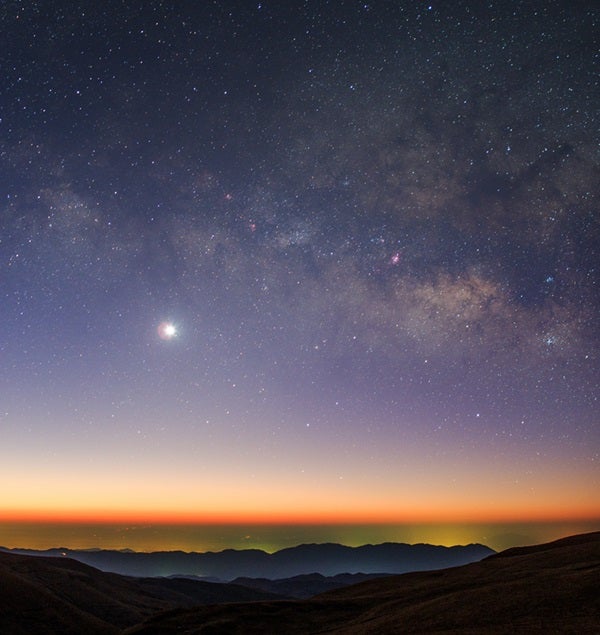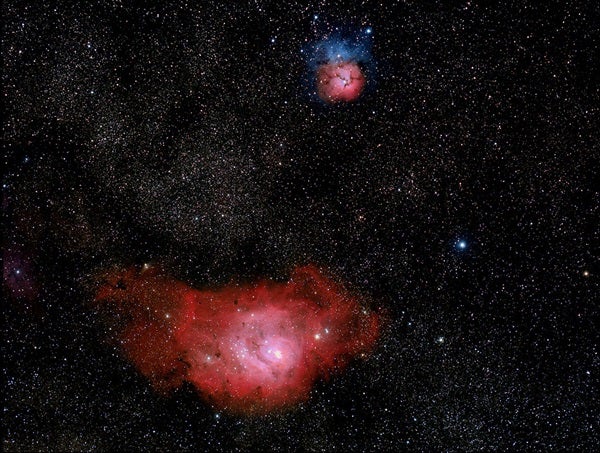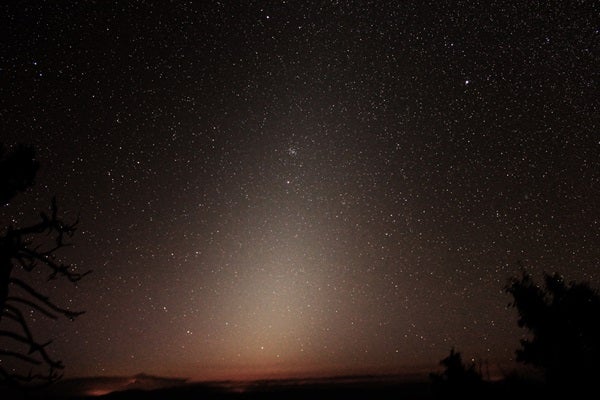In what seems a fitting tribute, the planet named after the Roman goddess of love shines brilliantly in the evening sky on Valentine’s Day. Venus gleams at magnitude –4.2 and shows up easily in the west-southwest within a half-hour after sunset. It grows even more prominent as darkness settles over the landscape. The planet doesn’t set until a bit after 8:30 p.m. local time. If you turn a telescope on Venus, you’ll see a disk that spans 17″ and appears about two-thirds lit.
Saturday, February 15
Last Quarter Moon occurs at 5:17 p.m. EST. Look for it either before dawn this morning (when it lies among the background stars of Libra and looks slightly more than half-lit) or after it rises around 1:30 a.m. local time tomorrow (when it stands against the backdrop of northern Scorpius and appears as a fat crescent).
Sunday, February 16
Mercury remains a tempting target early this week. The innermost planet stands 9° above the western horizon 30 minutes after the Sun sets tonight. It glows only at magnitude 0.8, however, which is nearly four times fainter than it appeared at greatest elongation last week. Although it may be difficult to spot against the twilight glow with your naked eye, binoculars will show it easily. Target the planet through a telescope and you will see a disk that spans 9″ and appears 22 percent illuminated.
Mars rises before 4 a.m. local time and climbs 20° above the southeastern horizon an hour before the Sun comes up. Glowing at magnitude 1.2 against the fainter background stars of Sagittarius the Archer, the ruddy world stands out nicely in the predawn darkness. But the real reason you should target Mars through binoculars or a telescope this morning is because of the company it keeps: The Red Planet passes between two of the Milky Way’s finest star-forming regions, the Lagoon Nebula (M8) and the Trifid Nebula (M20). These two Messier objects lie just 1.4° apart and will make a marvelous backdrop for astroimagers. Unfortunately, a telescope doesn’t add much to our view of Mars, revealing a bland disk that measures just 5″ across.
Tuesday, February 18
As spectacular as Mars’ passage between M8 and M20 yesterday was, this morning holds even more drama for observers in the western two-thirds of North America. Shortly before dawn, the waning crescent Moon slides in front of the Red Planet in a stunning occultation. You can view this event with your naked eye, but binoculars or a telescope reveal far more detail. Use a scope if you want to watch Mars fade away as Luna’s bright limb gradually overtakes it. Depending on your location, the Moon can take up to 15 seconds to completely cover the planet’s featureless disk. The occultation occurs earlier the farther west you live. Although Mars has already disappeared by the time the two objects rise along the West Coast, observers there can witness the planet’s equally stunning reemergence from behind the Moon’s dark limb. Those in the mountain states get to view the disappearance against a dark sky, while Midwesterners see the same event during twilight. Unfortunately, East Coast skygazers miss out because the occultation occurs after the Sun rises. Even so, they’ll enjoy a beautiful close conjunction between the two objects before dawn.
Wednesday, February 19
Less than an hour after Mars rises, Jupiter pokes above the southeastern horizon. There’s no mistaking the giant planet for any other object — at magnitude –1.9, it is by far the brightest point of light in the morning sky. The waning crescent Moon forms a pretty pair with Jupiter this morning, appearing just 4° to the planet’s right.
Thursday, February 20
The Moon moves eastward an average of 13° relative to the background stars each day. That motion carries it into western Sagittarius this morning, where it lies just 2.5° to the lower right of Saturn. The two rise shortly after 5 a.m. local time and appear impressive as twilight starts to brighten the sky. The ringed planet glows at magnitude 0.6, 10 times fainter than its brilliant neighbor, Jupiter.
This week offers skygazers an excellent chance to see the zodiacal light. From the Northern Hemisphere, late winter and early spring are great times to observe this elusive glow after sunset. It appears slightly fainter than the Milky Way, so you’ll need a clear moonless sky and an observing site located far from the city. Look for the cone-shaped glow, which has a broad base and points nearly straight up from the western horizon, after the last vestiges of twilight have faded away. The Moon stays out of the early evening sky until February 25.
Saturday, February 22
Two of the finest deep-sky objects shine prominently on February evenings. The Pleiades and Hyades star clusters appear highest in the south as darkness falls but remain conspicuous until well past midnight. The Pleiades, also known at the Seven Sisters and M45, looks like a small dipper to the naked eye. The larger Hyades forms the V-shaped head of Taurus the Bull. Although both look nice without optical aid, binoculars show them best.
Sunday, February 23
One of the sky’s largest asterisms — a recognizable pattern of stars separate from a constellation’s form — occupies center stage on February evenings. To trace the so-called Winter Hexagon, start with southern Orion’s luminary, Rigel. From there, the hexagon makes a clockwise loop. The second stop is brilliant Sirius in Canis Major. Next, pick up Procyon in the faint constellation Canis Minor, then the twins Castor and Pollux in Gemini, followed by Capella in Auriga, Aldebaran in Taurus, and finally back to Rigel.
New Moon occurs at 10:32 a.m. EST. At its New phase, the Moon crosses the sky with the Sun and so remains hidden in our star’s glare.












